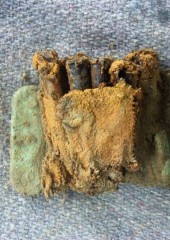So many isms, so little time...
In the last issue, we looked at the rise of Archaeological Theory (AT) and what it meant to the profession, today we shall be turning our sights on one of the early stars of AT: Functionalism. Ah yes, functionalism, that great paradigm of theory which looked at society as though it were a living organism with all its various factions and facets playing its own special part in supporting the function (get it?) of the whole. As you can probably imagine, if one of those subsystems were to say, break down (shock horror right?) it would be very bad for us all. This is because in this model, each part of society or its subsequent culture are viewed as intrinsically important to the smooth running or function of larger systems, thus falling under the umbrella of Systems Theory (a school of thought which is defined very basically in the same fashion as the aforementioned functionalism).
Now surely to the modern analytical mind with a greater understanding of sociology or the broader social sciences as a whole, this must read like an exceedingly flawed system, as it allows for little or no social mobility, with a society that must remain static. However in the late 19th century, notable functionalists such as August Comte, Herbert Spencer, Emile Durkein, Alfred Radcliffe-Brown and Bronislaw Malinowski were passionate about the idea that cultures acted as organisms, with their past easily explained in terms of their overall function in relation to one another as well as that culture as a whole. When the archaeologists of the mid-20th century felt that their intellectual efforts were effectively drying up, forward thinkers, like David Clarke, proposed a way of introducing science-based archaeological techniques to the profession, and functionalism had a significant part to play in that.
Much of functionalist archaeology was born out of functionalist anthropology, which placed a significant emphasis on social structures, the artefact values, as well as group based social systems. From cultural ecology was borrowed the concepts of the way in which technology and the environment interrelate; the impact upon the development of cultures caused by the exploitation of a society's environment. As a result, the relationship between culture and environment was explored as a process rather than merely a collection of assemblages. Once distilled by the functionalist archaeologist, society can be seen to develop to merely facilitate the sociological and cultural structure or function of the society itself. Furthermore, the more complex a culture and its technology may be, the more improved its knowledge of the environment in which it functions, and its technological machinations and manipulations within it will be.
As I mentioned above, all of this fits neatly into the New Archaeology and Processualism (yes, we have come back to it again, you will find this often with AT). Processualism expanded upon the more basic functionalism which introduced deduction, explanation, generalisation and quantitative scientific objectivity to the profession, and expanded the archaeological systems theory to include such important advances as the use of computers, the study of environmental remains, pollen diagrams, dating techniques, soil geomorphology and palaeopathology. This laid the groundwork for David Clarke's vision of a recognised and accepted scientific archaeology, and proves that processualism is not all bad. Ironically the term processualism was not even used to describe these archaeologists, until in the 1980s, when the self-proclaimed post-processualists created the word so that they could embody the archaeological parallel to the anthropological post-structuralists.
Once again, by the late 20th century, the archaeological profession had those members within it that saw the slow death of any true intellectual development within the field. Post-processualism or as it is sometimes referred to, interpretive archaeology, developed out of this general dissatisfaction or the malaise of the New Archaeology of Clarke's era. Unlike their adversaries, the processualists, the post-processualists rejected the idea that science, theory and data were separate entities, because in their opinion, data is always theory-heavy. Furthermore, they argued that interpretation was biased by the meanings we as archaeologists assign to them either consciously or subconsciously, and we merely assume those meanings and values assigned to ancient cultures as we cannot understand the mind of these ancient peoples. Additionally, no matter how detached and logical an archaeologist might consider themselves to be, it is impossible to disconnect the associations we might place on an object due to our place within the socio-political present in which we reside.
Finally, context is key to understanding meaning of assemblages within their culture or a culture's place within a larger society or landscape. Without this, we cannot begin to see beyond our own preconceptions and gain a deeper insight into the assemblages and cultures we examine as archaeologists. With contextualism, archaeologists have a tool which can be applied to understand an object, and how it has come about, by placing it in its relationship to the larger functioning whole, thus referring back to the environmental and behavioural context of action and expression. Contextualism also considers the relationships between the individual, society and the moment throughout the long-term, differing from the more simplistic views in a search for deeper meaning which is often tied to the historical context.
In the next Theory 101, I will be examining Archaeological Marxism in all its productive glory. If you have any questions about this or any of the themes covered in Theory 101, please send them to the editors who will be glad to pass them on to me to be answered in the next article. Thank you for joining me on this theoretical journey, and I hope you enjoyed the ride.




